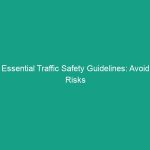Introduction
Working the night shift presents unique challenges and risks that can significantly impact the health and well-being of employees. The importance of health, safety, and Environment (HSE) practices cannot be overstated, especially when it comes to Safety for Night Shift Workers. Night shift work can disrupt circadian rhythms, leading to potential health issues such as fatigue, sleep disorders, and impaired cognitive function. Therefore, understanding and mitigating the risks associated with night shifts is crucial for both employers and employees.
In this article, we will delve into essential Safety practices, regulatory frameworks, best practices, and future trends in ensuring Safety for Night Shift Workers. By addressing these topics comprehensively, we aim to equip both workers and employers with the knowledge they need to foster a safer work environment.
Regulatory Frameworks
Regulatory frameworks play a significant role in establishing Safety Guidelines for night shift workers. These Regulations are designed to safeguard the health and Safety of employees, ensuring that their rights are protected and that employers are held accountable for maintaining a safe workplace.
Occupational Health and Safety Administration (OSHA)
In the United States, the Occupational Health and Safety Administration (osha) sets and enforces Standards that ensure safe and healthful working conditions. Employers are required to provide a safe workplace that is free from recognized Hazards that could cause death or serious physical harm. This includes taking special considerations for night shift workers who may face increased risks due to reduced visibility and altered sleep patterns.
International Labour Organization (ILO)
The International Labour Organization (ILO) provides a global framework for promoting safe and healthy working conditions. The ILO’s guidelines emphasize the need for employers to assess the risks associated with night work and implement appropriate measures. This includes ensuring adequate rest periods and providing necessary Training for night shift employees.
Key Regulations for Night Shift Work
- Work Hours Regulations: Many countries have laws regulating the maximum number of hours an employee can work at night, as well as mandatory rest periods.
- Health Surveillance: Employers may be required to conduct health assessments for night shift workers to monitor for fatigue and other related health issues.
- Training Requirements: Regulations may mandate specific training for night shift workers, focusing on Safe Practices and recognizing the signs of fatigue or other health concerns.
Best Practices for Safety
Implementing Best Practices is vital for enhancing Safety for Night Shift Workers. Employers can take proactive steps to mitigate risks and create a healthier work environment.
Risk Assessment
Conducting thorough risk assessments is the first step in identifying potential Hazards faced by night shift workers. This process should involve evaluating the work environment, equipment, and tasks performed during the night. By identifying risks such as inadequate lighting, fatigue, and potential for accidents, employers can implement targeted interventions to improve safety.
Scheduling and Workload Management
Effective scheduling is crucial for maintaining the health of night shift workers. Employers should consider rotating shifts to prevent prolonged night work, which can exacerbate fatigue. Additionally, managing workloads to prevent excessive overtime can help reduce stress and improve overall well-being. Shifts should ideally be structured to allow for adequate recovery time between night shifts.
Training and Awareness
Training programs should be tailored specifically for night shift workers, focusing on the unique challenges they face. Employees should be educated about the risks associated with night work, including the importance of managing fatigue and recognizing the signs of sleep deprivation. Regular training can empower workers to take proactive measures to protect their health.
Creating a Supportive Environment
Employers should foster a supportive environment that prioritizes the health and safety of night shift workers. This can include providing access to healthy food options during shifts, ensuring adequate lighting in work areas, and promoting open communication about safety concerns. Peer support programs can also help workers connect and share strategies for managing the challenges of night shifts.
Monitoring Health and Well-Being
Regular health monitoring is essential for identifying potential issues early. Employers can implement health screenings or wellness programs specifically for night shift workers. This proactive approach can help detect health problems before they become serious, ultimately contributing to a safer workplace. Encouraging employees to report health concerns without fear of retribution is also vital.
Challenges Faced by Night Shift Workers
Despite best efforts, night shift workers often face unique challenges that can impact their safety and well-being. Understanding these challenges is essential for developing effective strategies to mitigate risks.
Fatigue and Sleep Disorders
One of the most significant challenges for night shift workers is fatigue. Working at night can disrupt natural sleep patterns, leading to chronic sleep deprivation and increased risk of accidents. Studies have shown that night shift workers are more likely to experience sleep disorders, which can impair cognitive function and reaction times. This highlights the importance of prioritizing sleep health for night workers.
Reduced Visibility and Environmental Hazards
Many night shift jobs involve working in low-light conditions, which can increase the risk of accidents. Reduced visibility can make it difficult for workers to see hazards, leading to slips, trips, and falls. Employers should ensure adequate lighting in work areas and provide training on navigating potential hazards in low visibility conditions.
Social Isolation
Night shifts can lead to feelings of isolation, as workers may have limited social interaction with colleagues and family. This can contribute to mental health issues such as depression and anxiety. Employers should create opportunities for night shift workers to engage socially, whether through team-building activities or regular check-ins to foster a sense of community.
Difficulty Accessing Resources
Night shift workers may find it challenging to access essential resources, such as healthcare or wellness programs, that are primarily available during daytime hours. Employers should consider offering flexible access to health services and support programs to ensure night shift workers can prioritize their health and well-being.
Case Studies: Successful Implementations of Safety Practices
Learning from successful implementations of safety practices can provide valuable insights for organizations looking to improve Safety for Night Shift Workers. Here are a few notable case studies that highlight effective strategies.
Case Study 1: Manufacturing Industry
A manufacturing company implemented a comprehensive health and safety program specifically for its night shift workers. This program included regular training sessions focused on fatigue management and risk assessment. The company also adjusted shift schedules to allow for better work-life balance. As a result, they saw a significant reduction in workplace accidents and improved employee morale.
Case Study 2: Healthcare Sector
In a large hospital, night shift nurses faced high levels of fatigue and stress. The hospital introduced a wellness program that included meditation and stress management workshops. They also provided quiet rooms for short naps during shifts. Feedback from staff indicated a marked improvement in job satisfaction and a decrease in reported fatigue levels.
Case Study 3: Transportation Industry
A transportation company recognized the risks associated with night driving for its employees. They implemented a rigorous training program that focused on recognizing fatigue and managing long hours on the road. Additionally, they provided regular health check-ups and encouraged open discussions about mental health. This approach led to a decrease in accidents and improved employee retention.
Future Trends in Night Shift Safety
As the workforce continues to evolve, new trends are emerging in the realm of Safety for Night Shift Workers. Keeping an eye on these trends can help organizations stay ahead in promoting a safe and healthy work environment.
Technology and Safety Monitoring
Advancements in technology are paving the way for improved safety monitoring for night shift workers. Wearable devices that track fatigue levels and alert workers when they need to take breaks are becoming more common. These devices can provide real-time feedback, allowing workers to manage their health proactively.
Flexible Work Arrangements
The rise of remote work and flexible schedules is also impacting night shift work. More employers are exploring options for remote night work, allowing employees to work from home during night hours. This trend can help alleviate some of the challenges associated with night shifts, such as commuting and social isolation.
Increased Focus on Mental Health
There is a growing recognition of the importance of mental health in the workplace. Organizations are increasingly prioritizing mental health support for night shift workers, offering resources and programs to address the unique stressors of night work. This focus on mental well-being can lead to a more engaged and productive workforce.
Conclusion
Ensuring Safety for Night Shift Workers is an ongoing challenge that requires commitment from both employers and employees. By understanding the regulatory frameworks, implementing Best Practices, and addressing the unique challenges faced by night workers, organizations can create a safer and healthier work environment. The case studies highlighted in this article demonstrate that proactive measures can lead to significant improvements in safety and employee morale.
As we move forward, it is crucial to stay informed about emerging trends and continuously adapt strategies to meet the evolving needs of night shift workers. By prioritizing health and safety, we can empower night shift workers to perform their duties confidently and safely. Let’s commit to creating safer workplaces for all workers, regardless of their shifts.


